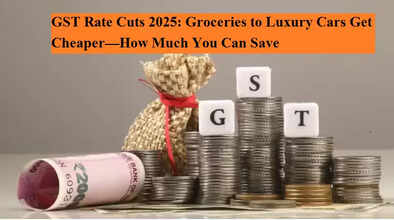GST Rate Cuts 2025: Groceries to Luxury Cars Get Cheaper—How Much You Can Save

The GST Council has announced a sweeping revision of Goods and Services Tax (GST) slabs, delivering relief for both middle-class households and high-income groups. From groceries and insurance premiums to gym memberships and even luxury cars, the new structure promises significant savings without requiring consumers to change their spending habits.
Relief for Everyday Households
The most visible impact will be on average Indian families.
-
A household with a monthly budget of ₹80,000 can save around ₹2,640 every month without altering consumption patterns.
-
The bulk of this saving comes from GST on essential groceries and food items, which has been reduced from 12% to just 5%.
-
In addition, gym memberships, salon services, and health as well as life insurance premiums will now attract lower GST, reducing regular monthly expenses further.
While the percentage benefit is highest for middle-income families, higher earners will also enjoy notable savings:
-
Families with a monthly budget of ₹3 lakh can save ₹5,916.
-
Those with ₹10 lakh monthly budgets can save up to ₹14,800.
However, the relative savings percentage for wealthier households is smaller compared to middle-class families.
What Gets Costlier?
Not everything has become cheaper. Certain premium goods, such as clothes and footwear priced above ₹2,500, will now attract an 18% GST rate, making them more expensive than before.
Big Boost for the Auto Sector
One of the sectors expected to gain the most is the automobile industry.
-
Small petrol and CNG cars up to 1200cc will now face only 18% GST, down from higher previous rates.
-
This means a car priced at ₹6 lakh will now cost just ₹5.48 lakh, leading to a direct saving of ₹52,000 for buyers.
-
Even mid-segment and luxury cars will see reduced prices, likely boosting demand in a sector that has faced sluggish growth.
Real Estate Also Gets a Push
The GST revision also benefits the real estate sector:
-
Cement, one of the most significant cost components in housing construction, has seen a reduction in GST. This translates to a 3.6% net reduction in housing costs.
-
With the repo rate cut by 1%, home loan interest rates are down, too. Borrowers with a ₹50 lakh home loan will save nearly ₹35 per lakh every month on EMIs.
Together, lower construction costs and cheaper financing are expected to revitalize the housing market, making homes more affordable for buyers.
How the New GST Slabs Change Spending
The latest GST changes are designed to:
-
Encourage consumption in critical sectors like automobiles, real estate, and insurance.
-
Provide direct household savings on daily essentials such as food and personal care.
-
Balance taxation by making some luxury segments costlier while easing the burden on essentials.
In effect, the reforms aim to leave more disposable income in the hands of consumers, while supporting key industries that drive India’s economic growth.
Final Takeaway
The GST Council’s latest rate restructuring is a win-win for consumers and industries alike. Middle-class families will enjoy bigger savings on groceries, insurance, and wellness services, while the auto and housing markets get a much-needed push through lower costs.
From kitchen essentials to luxury sedans, the revised GST structure ensures that every income group sees financial relief. However, shoppers splurging on premium fashion and footwear may need to spend a little extra.
Overall, the GST slab changes of 2025 are set to put more money back into the hands of millions of Indians, while providing a strong stimulus for economic growth.

